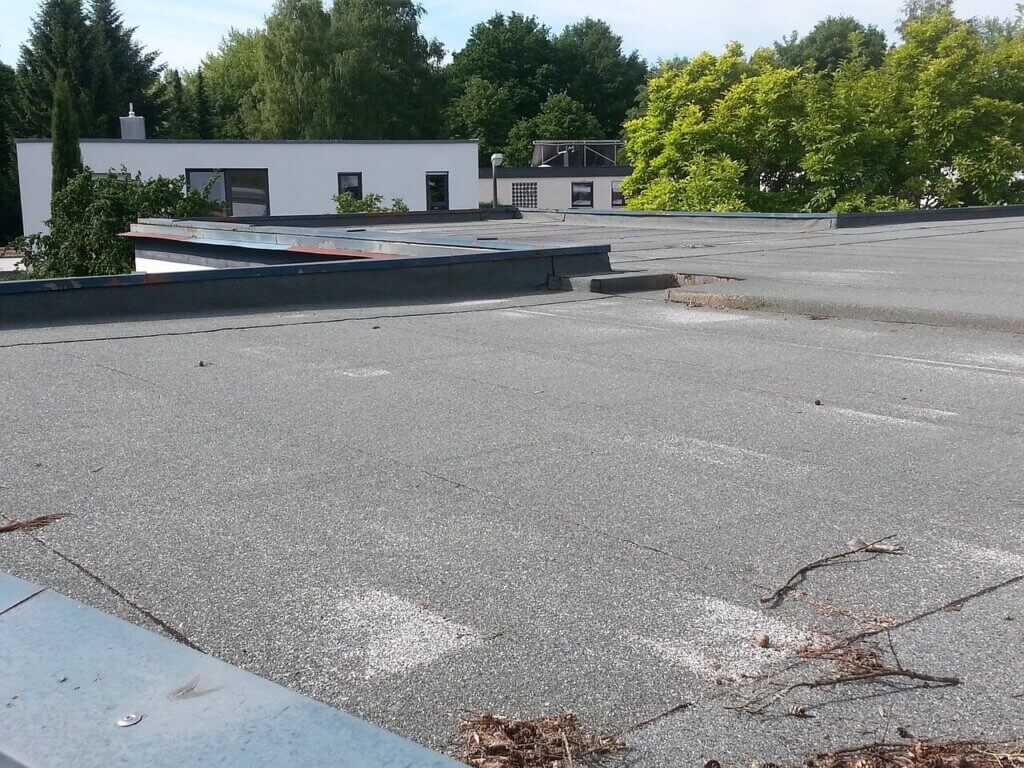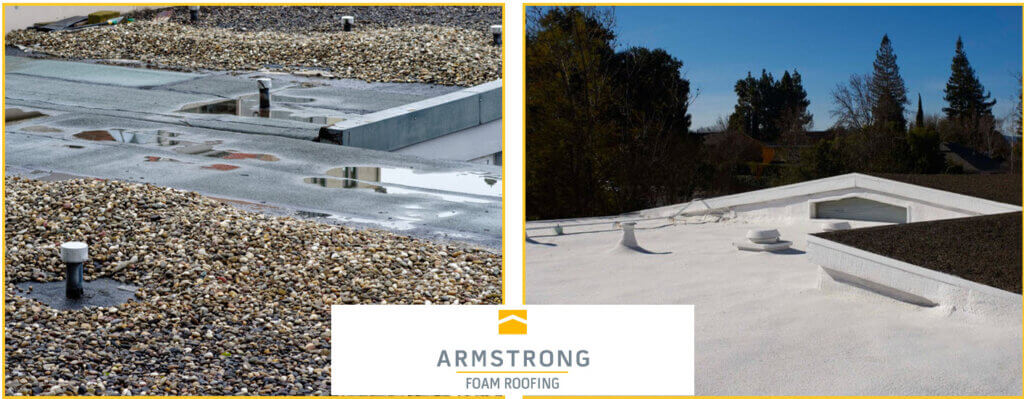Flat roofing is an economical and efficient choice for many San Francisco Bay Area homes and buildings, but even the most reliable roofs can eventually wear out and need to be replaced. Knowing when it’s time to replace your flat roof can save you from costly repairs and water damage. Here are some signs that it’s time to replace your flat roofing.
Age of Your Flat Roof
The average lifespan of a flat built-up roofing (BUR) system, such as tar and gravel, is anywhere from 10 to 20 years, depending on the material used. As your flat roof ages, it becomes less effective at keeping out moisture and can start to leak. If your flat roof is older than 20 years, it’s definitely time to consider a replacement.
Armstrong Foam Roofing can offer you a roofing solution that can last a lifetime with minimal maintenance. Foam roofing consists of a monolithic layer of solid closed-cell polyurethane foam that offers high insulation values, strength, and exceptional longevity.
Cracking and Chipping

If you notice that your roof is starting to crack or chip, it’s time to replace it. Cracking and chipping problems are common in flat BUR roofs. These problems can be caused by a number of different things, such as exposure to heavy rain, wind, or hail, and temperature fluctuations. Cracking and chipping can create problems for the roof, such as allowing water to seep in and cause leaks. This can lead to costly repairs, and can even lead to roof failure. Regular roof maintenance and inspections can help to identify and repair any issues before they become more serious.
Proper installation of the roof can help to reduce cracking and chipping problems in the future but the best solution for flat roofs is spray foam roofing since the foam forms a monolithic layer of solid closed-cell polyurethane foam. This seamless waterproof layer eliminates the issues resulting from expansion and contraction that permit water and microbes to seep in and damage your roof.
Pooling Water
One of the most common flat roof problems is pooling water or ponding. Flat roofs do not have much of a pitch or slope to them. When there is too much moisture, it can lead to water pooling on the roof. If you have a BUR roofing system, the water will eventually find its way through the seams and multiple layers of roofing material and leak into your home.

This can cause a variety of issues such as water damage, mold, and structural damage. To avoid these issues, it is important to take proactive steps to ensure that flat roofs are properly sloped, have adequate drainage, and are sealed and maintained regularly. Additionally, installing a waterproof membrane layer can help protect the roof and home from any pooling water. Taking these precautions can help to ensure that your flat roof is water-tight and prevent any major problems for a period of time. However, BUR roofing systems will begin to fail after 10 to 15 years and will need to be removed and replaced with new roofing material. This can be avoided by installing foam roofing which only needs to be recoated every 20 years to keep your roof functioning like new.
Roof Leaks
Conventional tar and gravel BUR roofing systems for flat roofs have seams that, in time, due to expansion and contraction start to separate and permit water and microbes to seep in and damage your roof. BUR roofing also utilizes flashing at the intersection between walls and other roofing features like chimneys, pipes, skylights, or compressors. The flashing is designed to provide waterproofing in these areas. Unfortunately, due to expansion and contraction, improper installation, and degradation over time, flashings lose their integrity and adhesion. Once the flashing on your roof begins to peel away. When this happens moisture and water begin to seep into your roofing structure and cause leaks.
If your flat roof is leaking, it’s a sure sign that it’s time for a replacement. Leaks can cause major structural damage to your home if not addressed promptly. If you want to avoid leaking roof issues, Armstrong’s foam roofing systems provide the ideal solution. The foam creates a monolithic watertight, seamless solid layer of foam that custom forms to the roofing substrate without the need for flashing (for more details please view our online video and read SPF Roofing: An Overview).
Curling Edges and Sagging
If you notice curling edges and sagging, your roofing system may have structural issues and should be replaced to avoid further damage to your home.
Curling Edges
Curling edges occur when the roofing material is exposed to extreme temperatures. This can cause the edges of the roofing material to curl up. This is a common problem on flat roofs, as the edges are more exposed to the elements. Curling edges can cause water to collect and pool on the roof, which can lead to more serious damage if not addressed promptly.
Sagging
Flat roofs can be a great option for buildings with limited space and another reason why they are so popular in the San Francisco Bay Area is that they are less costly to construct than pitched roofs, but they can be prone to sagging. Flat roofs are not able to support the same weight as pitched roofs, so they require more frequent maintenance and inspection. Sagging occurs when the roofing material is not properly secured or when the material used is not suitable for the climate and its weight places stress on the building envelope.
The most common cause of sagging is a lack of proper drainage. Poor drainage can cause water to pool on the roof, leading to excess weight and eventual sagging. If left unaddressed, sagging can lead to major structural damage and water leaks. Armstrong’s foam roofing systems can help you avoid sagging issues due to the fact that SPF roofing is not only durable but lightweight as well. It’s extremely important for flat roof homes to have ultra-lightweight roofing. Foam roofing systems weigh approximately 60 lbs per 100 square feet whereas a typical tar and gravel built-up roofing system can weigh 600 lbs per 100 square feet. Therefore foam roofing adds significantly less stress to the walls and beams (building envelope) of your home.
When You Decide to Replace Your Flat Roof
Replacing a flat roof is a major undertaking, but it’s an important one that can preserve the integrity of your home and protect your investment. Knowing when to replace a flat roof is key to preventing major damage and costly repairs.
It’s important to inspect your flat roof regularly and be aware of any signs of damage or wear. If you notice any of the above signs, it’s time to consider replacing your flat roof. Replacing a flat roof may be a challenging undertaking, but it’s extremely important in order to protect your home. A professional roofing contractor like Armstrong Foam Roofing can help you determine the best course of action and provide you with a quality roof that can last a lifetime with minimal maintenance that includes a recoating every 20 years. The recoating process can help protect your foam roof from UV, rain, and wind damage and protect the original layer of your foam roof.
Replacing your BUR flat roofing system with foam roofing is the best choice you can make but you need to keep in mind that your foam roofing system will only be as good as the individuals who apply it. As a result, you need to contact a local professional contractor, like Armstrong Foam Roofing, with years of proven expertise and a high degree of technical knowledge in foam roofing.
We offer a no-obligation Satellite Roof Estimate and you can also arrange a remote free consultation, either by phone at 1-887-777-1234, computer, Skype, or email. Along with all the virtual ways we are providing estimates, we also offer at-home (outside) estimates for your convenience. To find out more about our foam roofing systems and our installation process, contact Armstrong Foam Roofing today.

